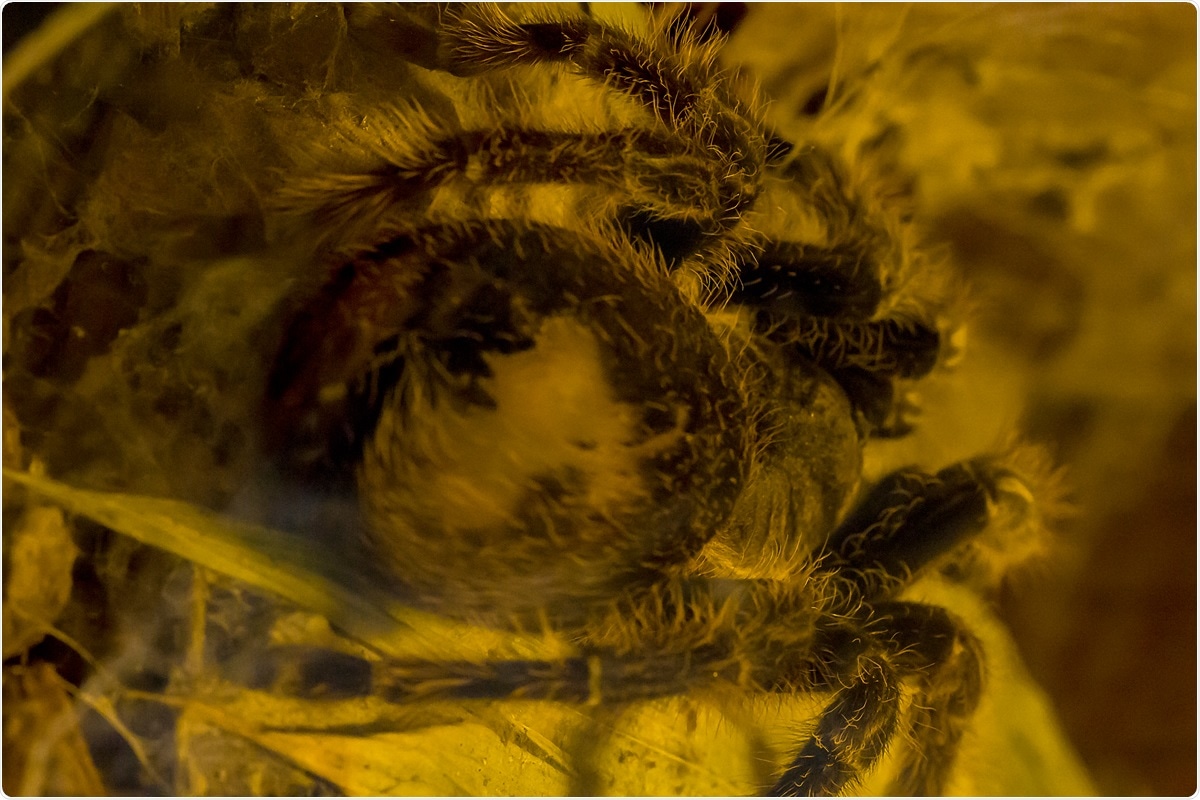University of Queensland researchers have found that a specific peptide found in spider venom could have properties that could make it useful in alleviating Pain in patients with irritable bowel syndrome. Their study titled, "A spider-venom peptide with multi-target activity on sodium and calcium channels alleviates chronic visceral pain in a model of irritable bowel syndrome," is published in the latest issue of the journal Pain.
Professor Richard Lewis from the Institute for Molecular Bioscience, University of Queensland, led the study along with Professor Stuart Brierley from Flinders University.
IBS
Irritable bowel syndrome (IBS) is a painful condition affecting thousands of people around the world. It causes pain in the abdomen, along with frequent disturbances in bowel movements, including constipation and diarrhea. Some may have predominantly diarrhea or predominantly constipation of both as their symptoms. There are usually no pathological changes or damage to the gastrointestinal tract, but the disease can be debilitating and may affect the quality of life.
The exact cause of this condition is not known. Usually, a pattern of gastrointestinal symptoms appears, which helps in diagnosing the condition. There are no definitive tests for diagnosis, and other conditions are usually excluded before a diagnosis of IBS is made. Treatment usually comprises of lifestyle changes, the inclusion of probiotics, and certain nutrients in the diet and certain medications and counseling.
What was this study about?
It has been noted in around 20 percent of the world population suffers from some form of pain or the other. In many individuals, pain may be relieved initially with pain medications, but soon tolerance develops, and there is a decrease in the efficacy of pain relievers.
One of the main symptoms of IBS seen commonly in many sufferers is chronic abdominal pain. Professor Lewis said, "All pains are complex, but gut pain is particularly challenging to treat and affects around 20 percent of the world's population. Current drugs are failing to produce effective pain relief in many patients before side effects limit the dose that can be administered."
Professor Brierley echoed this statement saying, "Internal organs have a complex network of sensory nerves that have a wide array of voltage-gated ion channels and receptors to detect stimuli... The hypersensitivity of these nerves in disease often contributes to the development of pain."
Molecular pain pathway
According to the researchers, there are several voltage-gated channels in the molecular levels affected with long term or chronic pain. These are voltage-gated sodium (NaV) and calcium (CaV) channels. Some of the channels pinpointed to play a role in chronic pain include NaV1.1, NaV1.3, NaV1.7–NaV1.9, CaV2.2, and CaV3.2, wrote the researchers. There is mention of several types of these channels in scientific literature, they wrote.
In this study
For this study, they first screened 28 spiders and finalized on the venom of the Venezuelan Pinkfoot Goliath tarantula or Theraphosa apophysis. This spider has a leg-span of up to 30 centimeters.

The Pinkfoot Goliath Tarantula is one of the largest spiders in the world. Image Credit: PURIPAT PENPUN / Shutterstock
The team describes the discovery and characterization of two novel peptides found in tarantula spider venom called Tap1a and Tap2a found from Theraphosa apophysis venom. These peptides were found to alter and modulate the activities of NaV and CaV3 channels.
Professor Lewis explained that the venoms contain hundreds of peptides capable of inhibiting voltage-gated ion channels from opening. He said, "Unfortunately these peptides aren't completely selective for pain targets. "Our goal was to find more specialized pain blockers that are potent and target pain sodium channels for chronic visceral pain, but not those that are active in the heart and other channels."
The study and experiments revealed that these peptides Tap1a and Tap2a inhibited the on-target NaV and CaV3 channels even when they were in nanomolar to micromolar concentrations. The selectivity remained off-target for the NaV1.6 and they had weak affinity for NaV1.4 and NaV1.5 at nanomolar to micromolar concentrations of Tap1a and Tap2a.
In IBS
The study also revealed that Tap1a was a more potent inhibitor of the afferent nerve fibers from the colon and the bladder. For this study, the team isolated mouse models of irritable bowel syndrome. On the administration of the peptide, they noted that the mechanical hypersensitivity of the colonic nerves in the mice was significantly reduced.
Conclusions and implications
The researchers wrote in conclusion, "These findings suggest that targeting a specific combination of NaV and CaV3 subtypes provides a novel route for treatment of chronic visceral pain." Abdominal pain in IBS, for example, could benefit from medication made from these peptides, if they were proven to be safe for use in human clinical trials.
Professor Lewis said, "We now have a really strong understanding of the structure and function of these spider venom peptides... The highly selective ones have potential as treatments for pain, while others are useful as new research tools to allow us to understand the underlying drivers of pain
Journal reference:
- Cardoso, Fernanda C; Castro, Joel; Grundy, Luke; Schober, Gudrun; Garcia-Caraballo, Sonia; Zhao, Tianjiao; Herzig, Volker; King, Glenn F; Brierley, Stuart M; Lewis, Richard J A spider-venom peptide with multi-target activity on sodium and calcium channels alleviates chronic visceral Pain in a model of irritable bowel syndrome, PAIN: August 17, 2020 - Volume Articles in Press - Issue - doi: 10.1097/j.pain.0000000000002041, https://journals.lww.com/pain/Abstract/9000/A_spider_venom_peptide_with_multi_target_activity.98296.aspx